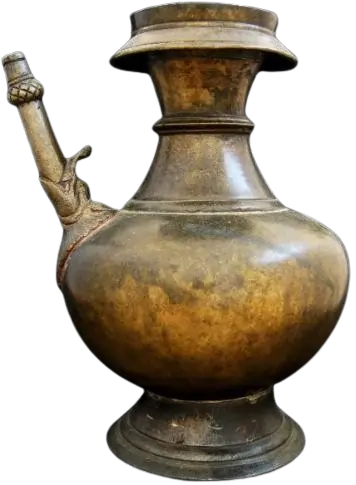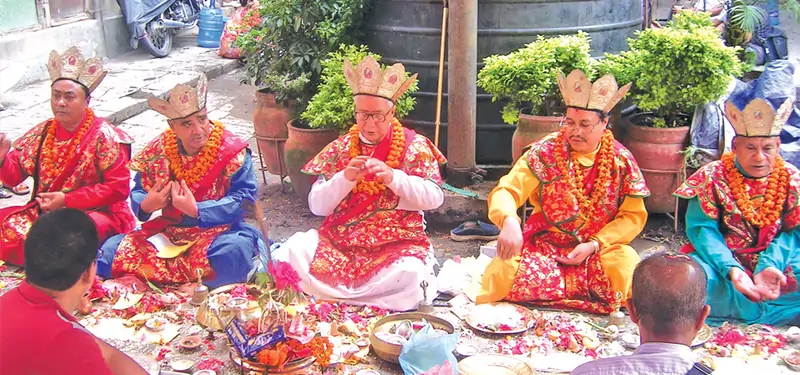Introduction
In the Bajracharya tradition, the 16-step puja is a highly respected ritual that honors deities through sacred offerings and mantras. Each step is deeply meaningful, representing devotion, purity, and the connection between worshippers and the divine. This puja is performed during the Gurumandala puja, Navagraha puja, Mha puja, and many other Bajracharya rituals.
This Bajracharya puja ritual is quite detailed. For those seeking a quicker and simpler way to perform puja rituals, please refer to Panchopachara Puja (पञ्चौपचार पूजा).
Essential Items: What you Need for Puja
To perform the 16-step puja in the Bajracharya tradition, certain items are essential. Each of these items plays a significant role in the ritual, enhancing the spiritual atmosphere and ensuring that offerings are made with devotion. Here’s a list of the required items:
Traditional Puja Utensils
- Puja Plate (पुजभ) – A plate to hold various offerings.

- Sina: Mu (सिन्ह:मू) – A container specifically for holding Sina or Tika.

- Conch Shell (संख) – A sacred conch used during the ritual for offering water.

- Conch Shell Stand (मस) – A stand to hold the conch securely.

- Bowl for Samay Baji: Lapicha (लंपिचा) – A bowl to hold the Samay Baji (a traditional Newar food offering). Traditional bowl is called Lapicha (लंपिचा).

- Sukunda (सुकुन्दा) – A traditional oil lamp used in the puja for light.

- Dhalacha (धालाचा) for Rice Wine – A container for offering rice wine.

- Small Brass Pitcher for Cow Milk – A small brass pitcher or any bowl to hold cow milk for offerings.

Offerings for the Puja
- Rice (Ashyata, अक्षता): This is a symbol of purity and abundance. Rice is used in various offerings throughout the puja, representing nourishment and gratitude.
- Incense (धुप): Burning incense creates a fragrant atmosphere that purifies the space. It is believed to attract positive energies and blessings during the ritual.
- Yellow Sina/Tika (सिन्ह:): This yellow powder is used for marking the forehead. It represents purity and auspiciousness, serving as a reminder of the divine presence.
- Red Sina/Tika (सिन्ह:): Like yellow sina, red tika is also applied on the forehead but signifies different energies and blessings. It adds to the spiritual significance of the ritual.
- Taya (ताये): Taya refers to popped rice paddy, which are often offered to deities. This offering symbolizes nourishment and sustenance.
- Cotton String (इता): A cotton string is used in the puja for light and burning fire. It represents the destruction of ignorance and the awakening of knowledge.
- Jajanka (जजंका): Jajanka refers to sacred cloth or fabric used in the ritual. It adds to the overall sanctity of the puja and is used to cover offerings.
- Flowers: Fresh flowers are essential in any puja, as they symbolize beauty, purity, and the transience of life. They are offered to deities as a sign of respect and devotion.
- Naivedya – Samay Baji: Naivedya refers to the food offerings made to the deities. Samay Baji is a special dish prepared for the puja, symbolizing abundance and gratitude.
- Cow Milk (सादुरु): Cow milk is considered sacred and is often offered during the puja. It symbolizes purity and nourishment, essential elements in the ritual.
- Rice Wine (थ्वँ): This fermented beverage is used as an offering in the puja, symbolizing celebration and joy. It is believed to enhance the spiritual atmosphere.
- Fruit and Sweets: Offering fruits and sweets is a way to show gratitude to the deities. They symbolize the sweetness of life and the abundance that comes from spiritual practices.
A Step-by-Step Guide to 16-Step Puja
Let’s explore each step to uncover the significance and purpose of this intricate ritual.
- Offer Flower
- Burn Incense (धुप)
- Keep rice (Akshyata) in hand, hold it together for Namaste, and once the mantra is completed, offer the rice to the deity or mandala (जाकि ज्वना विन्ति याये अले पूजा याये)
- Offer Water and Rice (धा: मण्ड:)
- Offer Sina or Tika (सिन्ह:)
- Offer Jajanka (जजका)
- Offer Rice and Flower (जाकिं पूजा याना स्वाँ छाये)
- Offer Naivedya (Food)
- Offer Cow Milk (सादुरु)
- Offer Rice Wine “Dhara/Dhala” (धारा/धाला)
- Offer Fruit and Sweets (फलफूल मह्रि चह्रि)
- Offer Light (मत बिये)
- Offer Fried Rice Grain “Taye” (ताये कया पूजा याये)
- Offer Rice, Water, and Flower (जाकि स्वाँ व ल: तया पूजा याये)
- Offer Rice and Money “Dakshina” (जाकि व दक्षिणा छाये)
- Pray 100 Syllables Vajrasattva Mantra and Offer Rice (शत्ताक्षर हवने जाकि पूजा याये)
1. Offering Flower to the Deity or Mandala
Offering flowers symbolizes the beauty and fleeting nature of life. This first step signifies the worshipper’s pure intent.
Sanskrit Mantra
ॐ स्वभाव शुद्धा सर्वधर्मा स्वभाव शुद्धोहं ।
शून्यता ज्ञानवज्र स्वभावात्मकोहम् ।
In English
Om svabhava shuddha sarva dharma svabhava shuddho ‘ham.
Shunyata jnana vajra svabhavatmakoham.
Meaning
I am pure by nature, all things are pure by nature. I am the essence of wisdom and emptiness.
2. Burning Incense (Dhup)
Incense represents the purification of the atmosphere, inviting the deity to the sacred space.
Sanskrit Mantra
भगवन श्री अमुक सद्वज्र विद्याराज नमोस्तुते
कर्तुमिच्छामि ते नाथ मण्डलं करूणात्मकम ॥
शिष्याणामनुकम्पार्थ युष्माकं पूजनाय च
सत्वानां पुण्य वृद्धार्थ बोधिचित्तोद्यायच ॥
तन्मे भक्तस्य भगवन् प्रसाद कर्तुमर्हसि
समन्वाहरन्तु मां बुद्धा जगदर्थ क्रियार्थदाः ॥
फलस्था बोधिसत्वाश्च याश्चान्या मन्त्रदेवताः
देवता लोकपालाश्च भूता: सम्वोधिसाधिताः ॥
शासनाभिरताः सत्वा: ये केचिद् वज्रचक्षुषः
अमुकोहं महावज्री अमुकोदयं मण्डल ॥
लिखिष्यामि जगच्छुद्यै यथाशक्तयुपचारत:
अनुकम्पामुपादाय सशिष्यस्य च तन्मम ॥
मण्डले सहिता सर्वे सान्निध्यं कर्तुमर्हथ
ओं आ: हूँ वज्र सुगन्ध वज्र धूपं निर्यातयामि
वज्र धूपं प्रतिच्छ स्वाहा ॥
In English
Bhagavan Shri Amuka Sadvajra Vidyaraja Namostute
Kartumichhami Te Natha Mandalam Karunatmakam
Shishyanamanukampartha Yushmakam Pujanaya Cha
Satvanam Punya Vriddhartha Bodhicittodyayacha
Tanme Bhaktasya Bhagavan Prasada Kartumarhasi
Samanvaharantu Mam Buddha Jagadartha Kriyarthadah
Phalastha Bodhisattvascha Yashchanya Mantradevatah
Devata Lokapalashcha Bhutah Samvodhisadhitah
Shasanabhiratah Satvah Ye Kechid Vajrachakshushah
Amukoham Mahavajri Amukodayam Mandala
Likhishyami Jagacchudyai Yathashaktayupacharat
Anukampamupadaya Sashishyasya Cha Tanmama
Mandale Sahita Sarve Sannidhyam Kartumarhatha
Om Ah Hum Vajra Sugandha Vajra Dhupam Niryatayami
Vajra Dhupam Praticcha Svaha
Meaning
This prayer is a request to the enlightened beings and spiritual deities, particularly to Vajrasattva and the supreme deities (referred to as “Sadvajra Vidyaraja”). The practitioner expresses a desire to perform a compassionate mandala offering for the benefit of all sentient beings. It seeks blessings for the spiritual growth of disciples, and the increase of their merit and bodhicitta (the intention to attain enlightenment for the benefit of all beings). The prayer also calls for the presence of Buddhas, Bodhisattvas, guardian deities, and other enlightened beings to assist in purifying the world and guiding the practitioner in creating the mandala with sincerity and devotion. The offering of incense (vajra dhupa) is a symbolic gesture, inviting these divine forces to accept the practitioner’s offerings and to bless the ritual with their presence. The prayer concludes with an appeal for the deities to acknowledge and accept the incense offering with reverence and respect.
3. Keep rice (Akshyata) in hand, hold it together for Namaste, and once the mantra is completed, offer the rice to the deity or mandala (जाकि ज्वना विन्ति याये अले पूजा याये)
Holding rice in Namaste symbolizes devotion. After chanting the mantra, the rice is offered to the deity or mandala.
Sanskrit Mantra
अद्य मे सफलं जन्म सफलं जीवितं च मे ॥
समये सर्वदेवानां भविताहं न शंसय: ॥
अवैवर्ती भविष्यामि बोधिचित्तैक चेतसा ॥
तथागत कुलोत्पतिम्ममाद्यस्यान्न शंसय: ॥
अग्रो मे दिवसो ह्रद्य यज्ञो मेद्य ह्यनुत्तर ॥
सन्निपातो भवेदद्य सर्वबुद्धां निमंत्रणात् ॥
औं कुसुमाञ्जलिनाथ हो ॥
In English
Adya me safalam janma safalam jivitam cha me ॥
Samaye sarvadevanam bhavitaham na shamsayah ॥
Avaivarti bhavishyami bodhicittaika chetasa ॥
Tathagata kulotpattim mamadyasyaan na shamsayah ॥
Agro me divaso hridya yajño medhya hyanuttara ॥
Sannipato bhavedadya sarvabuddham nimantranat ॥
Om kusumanjalinatha ho ॥
Meaning
The mantra expresses a profound declaration of spiritual success and fulfillment. It begins with a reflection that one’s life and birth have become meaningful and fruitful. The speaker, with unwavering certainty, acknowledges their alignment with all divine beings, stating that they will achieve the irreversible stage of awakening, driven by a focused mind dedicated to Bodhicitta (the aspiration to attain enlightenment for the benefit of all beings). It celebrates the birth into the lineage of Tathagatas (Buddhas), marking the present day as an auspicious occasion, and the ritual as the highest, with a gathering of all Buddhas. The mantra concludes with an invocation to Kusumanjalinatha, further highlighting the importance of offering and devotion in this sacred moment.
4. Offering Water and Rice (धा: मण्ड:)
Continuous offering of rice and water symbolize fertility and abundance.
Sanskrit Mantra
औं वज्रोदके हूँ ॥ ओं वज्र भूमौ ॥
ओं वज्रलेखे सुरेखे सर्वतथागता अधिष्ठानाधि तिष्ठन्तु
सुवर्ण जल धारे स्वाहा ।
In English
Om Vajrodake Hum
Om Vajra Bhumau
Om Vajralekhe Surekhe Sarvatathagata Adhisthanadhi Tishthantu
Suvarna Jala Dhare Svaha
Meaning
The mantra invokes the power of Vajra (symbolizing indestructibility and spiritual strength) and calls upon the sacred elements of water and earth to create a pure, divine foundation. It begins with Om Vajrodake Hum, invoking the Vajra’s purifying energy through water, followed by Om Vajra Bhumau, grounding the practice in the sacred earth. The mantra then asks for the divine presence and blessings of all Tathagatas (Buddhas), symbolized by precise, radiant lines, to empower and sanctify the ritual space. The phrase Suvarna Jala Dhare Swaha offers the golden, sacred water as an offering, completing the invocation for divine blessings and purification.
5. Offering Sina or Tika (सिन्ह:)
Sina (सिन्ह:) / Tika, a mark on the forehead, represents the third eye, invoking wisdom and divine sight. Bajracharyas use two colors of Sina: yellow and red. The yellow color is applied with the middle finger, and the red color is applied with the ring finger. The mantra used is:
Sanskrit Mantra
इदं ते परमं गन्धं पवित्रं घ्राण तर्पणम्
ददामि परमं भक्त्या प्रतिगृन्ह यथासुखम् ॥
सिन्दुरं सजलं शान्तं विचित्रं सुरसान्वितम्
निर्यातयाम्यहं प्रीत्या सर्वसिद्धिं प्रयच्छं मे ॥
ॐ वज्रगन्धे स्वाहा ॥
ओं आ: हूँ वज्र सिन्दुर तिलक भूषणे स्वाहा ॥
In English
Idam te paramam gandham pavitram ghrana tarpanam
Dadami paramam bhaktya pratigrinha yathasukham ॥
Sinduram sajalam shantam vichitram surasanvitam
Niryatayamyaham pritya sarvasiddhim prayachchham me ॥
Om vajragandhe svaha ॥
Om ah hum vajra sindura tilaka bhushane svaha ॥
Meaning
This mantra is a prayer of offering and devotion. The practitioner is offering a sacred and fragrant substance, described as the “supreme fragrance,” to satisfy and honor the recipient. With deep reverence and devotion, they ask the divine entity to accept the offering gracefully, providing peace and contentment in return. The second part refers to offering sindur (Sina / Tika), which is calming and pleasing. The practitioner asks for blessings of success and perfection through this heartfelt offering. The concluding mantras (Om Vajragandhe Swaha and Om Ah Hum Vajra Sindura Tilaka Bhushane Swaha) call for the spiritual power of Vajra (symbolizing strength and indestructibility) to accept the offering, bestowing blessings and adorning the practitioner with divine protection and grace.
6. Offering Sacred Thread “Jajanka” (जजंका)
Offering the sacred thread (जजंका) symbolizes protection and the bond between the deity and the worshipper.
Sanskrit Mantra
ॐ वज्र वस्त्रालंकार पूजामेघ समुद्र स्फरण यज्ञोपवीत
बोध्यंग दृढकवच वस्त्र वाससे स्वाहा ॥
In English
Om Vajra Vastralankara Pujamegha Samudra Spharana Yajnopavita
Bodhyanga Dridhakavacha Vastra Vasase Svaha ॥
Meaning
This mantra is an offering of the sacred clothing and adornments to the deity. It symbolizes providing the deity with divine robes and protective armor, representing purity and spiritual strength. The mantra invokes the deity’s blessings for steadfast protection and wisdom, as symbolized by the ritual offering of the sacred thread (yajnopavita) and garments.
7. Offering Rice and Flower (जाकिं पूजा याना स्वाँ छाये)
Offering flowers represent purity, while rice symbolizes prosperity. Both are offered for blessings of peace and well-being.
Sanskrit Mantra
स्वस्ति वः कुरुतां बुद्धा स्वस्ति देवाः सशक्रकाः ।
स्वस्ति सर्वाणि भूतानि सर्वकालं दिशन्तु वः ॥
बुद्ध पुण्यानुभावेन देवतानां मतेन च ।
यो यो अर्थः समभिप्रेतः सर्वोर्थोद्य समृध्यताम् ॥
स्वस्ति वो द्विपदे भोन्तु स्वस्ति वोस्तु चतुष्पदे ।
स्वस्ति वो ब्रजतां मार्गे स्वस्ति प्रत्यागतेषु च ॥
स्वस्ति रात्रौ स्वस्ति दिवा स्वस्ति मध्ये दिनेस्थिते ।
सर्वत्र स्वस्ति वो भोन्तु मा चैषां पापमागमत् ॥
सर्वे सत्वाः सर्वे प्राणाः सर्वे भूताश्च केवलाः ।
सर्वे वै सुखिन: सन्तु सन्तु सर्वे सन्तु निरामयाः ॥
सर्वे भद्राणि पश्यन्तु मा कश्चित् पापमागतम् ।
यानीह भूतानि समागतानि
स्थितानि भूमावथ वान्तरिक्षे ।
कुर्वन्तु मैत्री सततं प्रजासु
दिवा च रात्रौ च चरन्तु धर्मम् ।
ओं आः हूं वज्रपुष्पम् प्रतिच्छ स्वाहा ॥
In English
Swasti vaḥ kurutāṃ buddhāḥ swasti devāḥ saśakrakāḥ ।
Swasti sarvāṇi bhūtāni sarvakālaṃ diśantu vaḥ ॥
Buddha puṇyānubhāvena devatānāṃ matena ca ।
Yo yo arthaḥ samabhipretaḥ sarvārthodya samṛdhyatām ॥
Swasti vo dvipade bhontu swasti vōstu catuṣpade ।
Swasti vo brajatāṃ mārge swasti pratyāgateṣu ca ॥
Swasti rātrau swasti divā swasti madhye dinesthite ।
Sarvatra swasti vo bhontu mā caiṣāṃ pāpamāgamat ॥
Sarve sattvāḥ sarve prāṇāḥ sarve bhūtāśca kevalāḥ ।
Sarve vai sukhinaḥ santu santu sarve santu nirāmayāḥ ॥
Sarve bhadrāṇi paśyantu mā kaścit pāpamāgatam ।
Yānīha bhūtāni samāgatāni
Sthitāni bhūmāvatha vāntarikṣe ।
Kurvantu maitrī satataṃ prajāsu
Divā ca rātrau ca carantu dharmam ।
Oṃ āḥ hūṃ vajrapuṣpam praticcha svāhā ॥
Meaning
This Sanskrit prayer invokes blessings and well-being from the Buddhas, deities, and all beings for the practitioner and all sentient life. It begins by asking for auspiciousness from Buddhas and celestial beings, wishing for peace and success at all times. The prayer acknowledges the power of the Buddha’s virtues and the goodwill of the deities to ensure that all desired outcomes are fulfilled and prosper. It extends blessings to both two-legged and four-legged beings, wishing safety on their journeys and in their homes. The prayer emphasizes well-being during day and night, asking that no harm comes to anyone. It concludes with a universal wish that all beings are happy, healthy, and free from suffering, always walking the path of righteousness with kindness towards each other. The final lines emphasize the offering of a symbolic flower (vajra-pushpam), signifying devotion to the spiritual path and its practices.
8. Offering Naivedya (Food)
Naivedya, food offered to the deity, represents nourishment and the sustaining power of life.
Sanskrit Mantra
ॐ वज्र समयाचारं खाद्य भोज्यादिकं प्रभो
महायान षडरस संयुक्तं नैवेद्यं सर्व
संयुक्तं खाद्य भोज्य समन्वितम्
वर्ण गन्ध रसोपेतं प्रतिगृन्ह यथासुखम् ।
औं वज्र नैवेद्यं प्रतिच्छ स्वाहा ।
In English
Om Vajra Samayāchāraṃ khādya bhojyādikaṃ prabho
Mahāyāna ṣaḍrasa saṃyuktaṃ naivedyaṃ sarva
Saṃyuktaṃ khādya bhojya samanvitam
Varṇa gandha rasopetaṃ pratigṛṇha yathāsukham.
Auṃ Vajra Naivedyaṃ pratichcha svāhā.
Meaning
The mantra is an offering prayer, in which the practitioner presents food and drink to the deity Vajrasattva. The offering consists of various types of food, symbolizing the six tastes (sweet, sour, salty, bitter, pungent, and astringent), representing nourishment for both the body and spirit. The mantra requests Vajrasattva to graciously accept this offering, which is filled with colors, fragrances, and flavors. The prayer emphasizes the sacredness of the offering and invokes blessings from Vajrasattva, asking for the food to be received with pleasure. The phrase concludes with the traditional offering invocation, Om Vajra Naivedyam Pratichha Svaha.
9. Offering Cow Milk (सादुरु)
Cow milk symbolizes purity, nurturing, and sustenance, offered to nourish the soul.
Sanskrit Mantra
औं आ सर्व तथागत बोधिचिंतामृत धारे स्वाहा ॥
In English
Om ah sarva tathagata bodhicintamrita dhare svaha.
Meaning
I offer the nectar of wisdom to all enlightened beings. Please accept it and bless me.
10. Offering Rice Wine “Dhara/Dhala” (धारा/धाला)
Rice wine (थ्वँ) is offered to signify surrender and the release of ego, connecting with the divine in a deeper way.
Sanskrit Mantra
ॐ नमो भगवते वीरवीरेश्वराय हूँ हूँ फट् स्वाहा ।
ॐ नमो महाकल्पाग्नि सन्निभाय हूँ हूँ फट् स्वाहा।
ॐ नमो जटामकुटोत्कटाय हूँ हूँ फट् स्वाहा ।
ॐ नमो द्रंष्ट्राकरालोग्रभीषणमुखाय हूँ हूँ फट् स्वाहा ।
ॐ नमो सहस्रभुज भास्वराय हूँ हूँ फट् स्वाहा ।
ॐ नमो असि मूशल परशु पाश त्रिशूल खट्वाङ्ग धारिणे हूँ हूँ फट् स्वाहा ।
ॐ नमो व्याघ्रचर्म धारये हूँ हूँ फट् स्वाहा ।
ॐ नमो महाधूमान्धकाराय वपुषाय हूँ हूँ फट् स्वाहा ।
In English
Om Namo Bhagavate Veeravireshvaraya Hum Hum Phat Swaha
Om Namo Mahakalpagnisannibhaya Hum Hum Phat Swaha
Om Namo Jatamakutotkataya Hum Hum Phat Swaha
Om Namo Dranshtrakaraalograbhishanamukhaya Hum Hum Phat Swaha
Om Namo Sahasrabhuja Bhasvaraya Hum Hum Phat Swaha
Om Namo Asi Mushala Parashu Pasha Trishula Khatvanga Dharine Hum Hum Phat Swaha
Om Namo Vyaghracharmadharaye Hum Hum Phat Swaha
Om Namo Mahadhumandhakaraya Vapushaya Hum Hum Phat Swaha
Meaning
The given mantras are powerful invocations to various deities and cosmic forces, emphasizing the practitioner’s reverence and connection to the divine. The chant begins with a respectful salutation to Veeraveereshwara, the embodiment of bravery and strength, expressing the desire for empowerment and protection. Following this, the practitioner calls upon the Mahakal, likening it to a sacred fire that purifies and transforms. The subsequent mantras invoke fierce and protective aspects of deities, including those associated with the jata-makuta (matted hair), representing ascetic power, and the dhrishtaakarala (fearsome face), symbolizing the removal of obstacles. Each invocation reinforces the theme of strength, protection, and spiritual vigor, as they acknowledge the formidable attributes of deities associated with various weapons and protective qualities, ultimately seeking blessings for overcoming challenges and achieving spiritual goals. The repetition of hum hum phat swaha serves to amplify the intentions of the mantras, invoking divine energy and affirming the practitioner’s devotion.
This mantra invokes various powerful and fierce aspects of a divine being, asking for protection, strength, and destruction of obstacles.
11. Offering Fruit and Sweets (फलफूल मह्रि चह्रि)
Fruits symbolize the fruits of labor, while sweets represent happiness and fulfillment.
Sanskrit Mantra
ॐ सर्ववित् आदर्शन फल मूलाय स्वाहा ।
In English
Om sarvavit adarshana phala mulaya svaha.
Meaning
I offer these fruits. May they bring wisdom and blessings.
12. Offering Light (मत बिये)
Light symbolizes the destruction of ignorance and the awakening of knowledge.
Sanskrit Mantra
नेत्रा विरामा बहुरत्न कोषा नराधिपारर्चित्तपाद पद्मा
ज्ञानं प्रदीपा हतमोह ज्वाला ये दीपमाला रचयन्ति तत्र ॥
ओँ आ: हूँ वज्र दीपे हिँ प्रतिच्छ स्वाहा ॥
In English
Netrā virāmā bahuratna koṣā narādhipārchittapāda padmā
Jñānaṁ pradīpā hatamoha jvālā ye dīpamālā racayanti tatra
Oṁ āḥ hūṁ vajra dīpe hiṁ praticcha svāhā
Meaning
The lamp stands as a resting place for the eyes, a treasury filled with many gems, adorned by the feet of kings. The light of knowledge dispels the darkness of ignorance, and those who arrange the series of lamps in this place are blessed. Oṁ āḥ hūṁ, O vajra lamp, receive this offering.
The mantra invokes divine light to dispel ignorance, symbolizing the spiritual illumination that enlightens the mind, heart, and soul, while expressing reverence and devotion.
13. Offering Fried Rice Grain “Taye” (ताये कया पूजा याये)
Taya – ताये, popped rice paddy symbolizes the cycles of life and death, reminding us of life’s impermanence.
Sanskrit Mantra
ये धर्म्मा हेतु प्रभावा ।
हेतु स्तेषां तथागतो ह्यवद् तेषां च यो निरोध एवंवादी महाश्रमण ।
In English
Ye dharmā hetu prabhavā
hetuṁ teṣāṁ tathāgato hyavad teṣāṁ ca yo nirodha evaṁvādī mahāśramaṇaḥ.
Meaning
Of those phenomena (dharmas) that arise from causes,
The Tathagata (the Buddha) has explained the cause,
And also their cessation,
Thus speaks the Great Ascetic.
This mantra is summarizing the Buddha’s teaching on causality. It conveys the essence of dependent origination, where all phenomena arise due to specific causes, and their cessation occurs when those causes are eliminated. The Tathagata (Buddha) explains both the arising of things through causes and their cessation, thus marking his profound understanding of the nature of existence.
14. Offering Rice, Water, and Flower (जाकि स्वाँ व ल: तया पूजा याये)
Offering of rice, flower and water (जाकि स्वाँ व ल: तया पूजा याये) signify the earth’s bounty and the blessings of nature.
Sanskrit Mantra
ॐ अकारोमुख सर्वधर्माणाद्यनुत्पन्नत्वात् ओं आ: हूँ फट् स्वाहा ॥
In English
Om akara mukha sarvadharmanaadyanutpannatvat om ah hum phat svaha.
Meaning
From emptiness, all things arise and dissolve. I offer these to the deity.
15. Offering Rice and Money “Dakshina” (जाकि व दक्षिणा छाये)
Dakshina, a financial offering, shows gratitude and devotion to the spiritual path.
Sanskrit Mantra
मञ्जुश्री कुमार भूताय भूताय बोधिसत्वाय महासत्वाय
महाकारुणिकाय तण्डुल देवदक्षिणां सम्प्रढोषयाम्यहम् ।
In English
Manjushree kumara bhootaya bhootaya bodhisattvaya mahasattvaya
Mahakarunikaya tandula devdakshinam sampradhoshayamyaham.
Meaning
I offer rice as an offering to Manjushri, the youthful divine being, the Bodhisattva of great wisdom and virtue, the great being of immense compassion.
16. Pray 100 Syllables Vajrasattva Mantra and Offer Rice (शत्ताक्षर हवने जाकि पूजा याये)
The concluding step purifies the mind and soul. Praying 100 syllables Vajrasattva mantra and offering rice signifies the final act of surrender and devotion.
Sanskrit Mantra
ॐ वज्रसत्व समय मनुपालय ॥
वज्रसत्वत्वेन प्रतिष्ठो ॥
दृढो मे भव ॥
सुतुष्यो मे भव ॥
सुपोष्यो मे भव ॥
अनुरक्तो मे भव ॥
सर्व सिद्धि मे प्रयच्छ ॥
सर्व कर्मसु च मे चित्त श्रियं कुरु ।
हूँ हहहह हो भगवन ॥
सर्व तथागत वज्र मा मे मुञ्च वज्री भव ॥
महासमयसत्व आ: ॥
In English
Om Vajrasattva samaya manupalaya |
Vajrasattvathvena pratishtho |
Dridho me bhava |
Sutushyo me bhava |
Suposhyo me bhava |
Anurakto me bhava |
Sarva siddhi me prayaccha |
Sarva karmasu ca me citta shriyam kuru |
Hum ha ha ha ha ho bhagavan |
Sarva tathagata vajra ma me muñcha vajri bhava |
Mahasamayasattva ah |
Meaning
This 100-syllable Vajrasattva mantra serves as a powerful invocation for the presence and blessings of Vajrasattva, the embodiment of compassion and purity. It begins by expressing a deep wish for Vajrasattva to protect and uphold the practitioner throughout their spiritual journey. The mantra requests the establishment of Vajrasattva’s essence within the practitioner, ensuring a firm and steadfast nature that is both fulfilled and nourished. It also seeks the divine support in achieving all accomplishments, emphasizing the desire for clarity and success in all actions. Additionally, it invokes the collective strength of all Tathagatas (Buddhas), asking Vajrasattva to never abandon the practitioner, thus fostering an enduring connection to enlightenment. The closing lines highlight the aspiration for the great realization of the ultimate truth, embodying the practitioner’s commitment to the path of awakening.
Read more details about 100 Syllables Vajrasattva Mantra.
Conclusion: A Devotional Journey of the Soul
The 16-step puja by Bajracharya is more than a ritual; it’s a spiritual journey. Each offering and mantra is a step towards purity, wisdom, and divine connection. Through this practice, the worshipper cultivates devotion, selflessness, and a deep sense of peace, aligning with the divine. By completing these steps, one strengthens their bond with the deity and the universe, seeking blessings for themselves and all beings.

